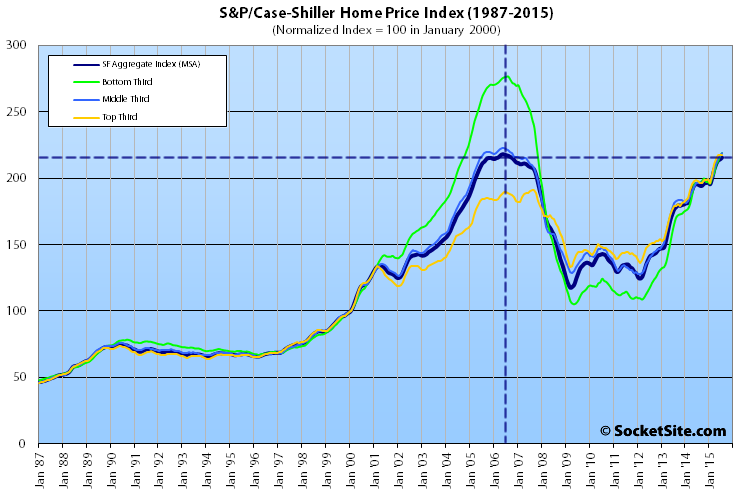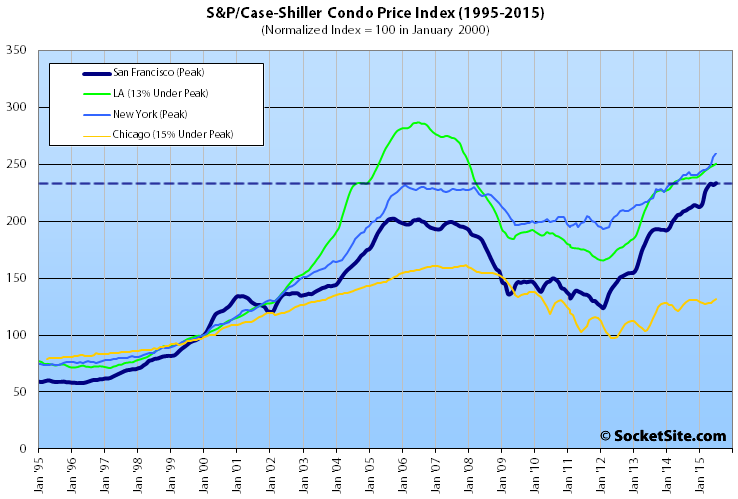Having ticked up 0.6 percent in July, and gained 59 percent since January 2010, the Case-Shiller Index for single-family home values within the San Francisco Metropolitan Area is within 1.2 percent of its 2006 peak and 10.4 percent higher versus the same time last year.
That being said, while the index for the bottom third of the market gained 1.0 percent in July (up 11.2 percent year-over-year), and the index for middle third of the market gained 0.9 percent (up 11.7 percent year-over-year), the index for the top third of the market was unchanged for the second month in a row but remains 9.8 percent higher versus the same time last year.
According to the index, single-family home values for the bottom third of the market in the San Francisco MSA have more than doubled since 2009 and are back to October 2004 levels (21 percent below an August 2006 peak); the middle third is back to July 2005 levels (2 percent below a May 2006 peak); and home values for the top third of the market remain at the all-time high recorded in May (13.7 percent above the previous peak reached in August of 2007).
Having slipped 0.5 percent in June, San Francisco condo values ticked up 0.7 percent in July to a new all-time high, up 12.0 percent year-over-year and 15.4 percent higher than in October of 2005, the peak of the previous cycle.
The index for home prices across the nation gained 0.7 percent in July and is running 4.7 percent higher on a year-over-year basis, but remains 5.2 percent below a July 2006 peak.
The long-term average annual home price appreciation for San Francisco measured 4.2 percent in 2006, at which point the city was deemed “bubble-proof,” in part due to the inability to build on large swaths of underdeveloped land, such as Treasure Island.
Our standard SocketSite S&P/Case-Shiller footnote: The S&P/Case-Shiller home price indices include San Francisco, San Mateo, Marin, Contra Costa, and Alameda in the “San Francisco” index (i.e., greater MSA) and are imperfect in factoring out changes in property values due to improvements versus appreciation (although they try their best).


The big difference of course being that all three tiers are in alignment showing a more balanced set of housing across the board. My feeling has been that so long as these all move in unison we’re probably not going to see a major correction. Rents and low interest rates are driving the market along the bottom and middle tiers and crazy wealth driving the top tier. Also of interest is the proximity of the NY and SF lines as SF continues to spread. Wonder if NY is inclusive of Brooklyn? I suspect not, but given how much Brooklyn has become a major overflow / hub of activity vis a vis Manhattan I would be interested to see that line as well.
I think that we must take into consideration current world events such as world wide financial uncertainty, crisis, natural disasters, terrorism… the ethers are stirring and the world is in a mess…
What do you mean? take into consideration how?
Yes, these are definitely headwinds that could stall a red hot housing market. Especially the downward drift in the stock market.
So like, basically, the last 100 years. Got it.
Would love to be able to point to a period when the world is not in a mess, free of “world wide financial uncertainty, crisis, natural disasters, terrorism”.
Nice headline, but consider that this index is not inflation adjusted, and it’s been nearly 10 years since the peak.
SF has forever had relatively more expensive real estate than most US cities.
Does that make it bubble proof? No. I think a (likely) correction is coming but the downside won’t be huge. Anyone’s guess but hard to see more than a 10% drop.
Right now SF’s affordability is below its historic norm (which isn’t great to begging with). The fact it has bounced back to basically peak levels when the average across the US has housing more than 5% below its peak just means SF is relatively more unaffordable than it was even at the peak. Compared to most other cities.
Bottom line, price appreciation may be flat for a number of years to come and rents may have peaked too.
The market fell out in 09/10 because people had to sell and there were no buyers with liquidity. Those who did buy ended up getting good deals relatively speaking. So even if the markets continued to drop further I’m not sure we’re going to see a whole lot of Apple to Apple 10% drops anytime soon short of maybe a few egregious overbids here and there (ahem, 2610 Scott).
I’d think 10% is the max drop. Several real estate agents in my area expecting it to drop 5% and not much more.
World economy or not, SF seemed to be hitting a ceiling. There is a limit to what tech workers can afford in a loan even with low rates and given most are young and have minimal down payments.
Rents may flatten too and especially if there is an acceleration of tech workers moving to the Easy Bay to live and moreso if tech companies continue moving to Oakland instead of locating in SF.
Interested in hearing the rationale for the 5-10% estimate.
Not that I am arguing that we are slightly above the affordability window, but wanted to hear how that number was estimated.
Truly it is anyone’s guess.
SF is at historic lows on affordability compared to other areas being more affordable than their historic average. rents seem to be peaking. More young professionals seem to be willing to live in the East Bay and own rather than pay outrageous rent in SF.
Add in a likely interest rate increase next year and I think its a safe bet prices have peaked for a while (its all cyclical) in SF.
Historically, when there have been real estate downturns, SF has not dropped as much as other areas. So while no one can say how much it will drop, a drop seems likely. Even if minimal. Until the next cycle in 5 or 6 years when the millennial bubble group (23/24/25) starts to form families and purchase homes.
Right now SF real estate is not a good investment given other markets and rent control maybe stiffening. That is another factor to throw into the mix.
Real Estate agents are supposed to remain optimistic, personally, I would think minus 20% plus (within 212 years) in the SF Bay Area since we had the biggest bull market. Real Estate Bear should accompany the stock market correction and I’m expecting a crash before the end of the year. It’s gonna be interesting to see how China plays out since currency controls exist and legally China Nationals can only take $50,000 out annually. I understand they move their money out through corporations but China is cracking down on corruption so their ability to dump may be limited.
Can someone help me with aligning CS to what appears to be reality here?
Im financially trained, understand stats etc. Live in Noe Valley many years, my house is worth say 35% over 2006 peak. Nice house, block, views, renovated to nice level, but its a “normal” house and not highly unusual for SF.
How does CS say were just hitting 2006 peak here?
Good question. I live in an average SF neighborhood. Miraloma Park. The prices here are at all time highs. Check the listing and sale prices. This is a middle third neighborhood and recent sale prices do not jive with what CS is reporting.
Louis and Dave, the data is for the SF MSA, not just the city of SF. The SF MSA includes 5 counties, as detailed in the footnote at the end of the SS story above.
Louis, you live in Noe. Congrats, you are in one of the top 4 or 5 neighborhoods in the city in terms of raw net increases in value. The rest of the city is still catching up. Rising tide lifts all boats but there is a mass averaging of the rest of the city which is contributing to the aggregate rise in value. The disparity between neighborhoods is shrinking and more parts of the city are enjoying the benefits of these higher values.
So to the guy that says prices will drop 5-10%. Maybe, and no one knows. But I’d bet that the levels stick where they are; and that other gentrifying areas will continue to increase in value. This is happening all over the city already and has been. Bacically no inventory in prime areas. Few homes a month at best. But homes all over the outer richmonds / sunsets, ****Parks, close to 280 areas are all experiencing massive growth as would be renters suck it up and buy whatever they can afford wherever they can afford it.
Mo people, Mo expensive housing.
Housing prices have reached “a permanently high plateau”.
Nothing is permanent